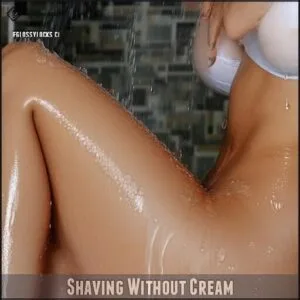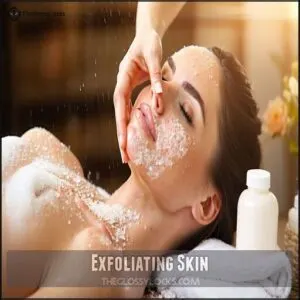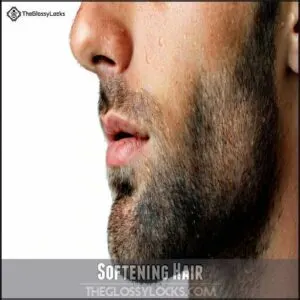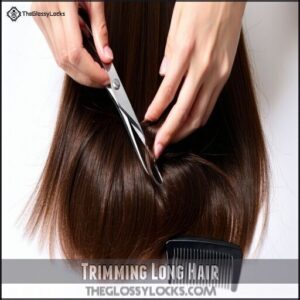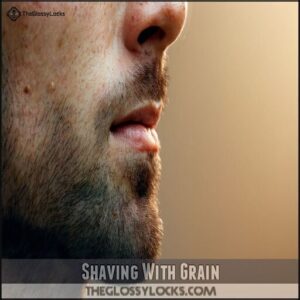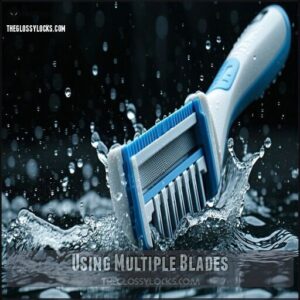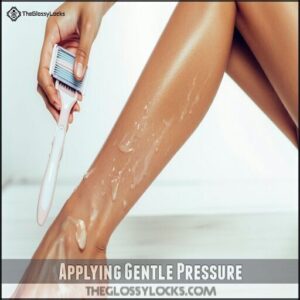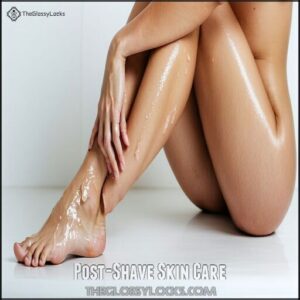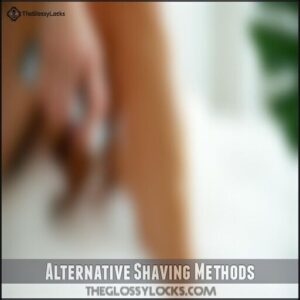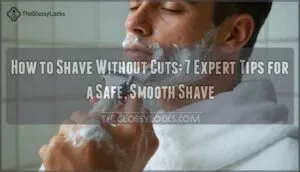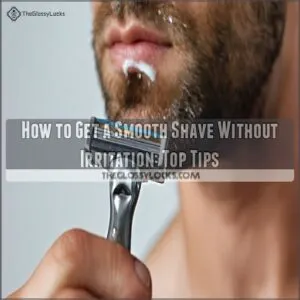This site is supported by our readers. We may earn a commission, at no cost to you, if you purchase through links.
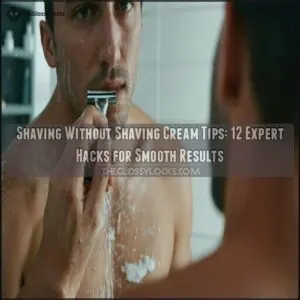
Try warm water to soften hair follicles, or substitute with olive oil, coconut oil, hair conditioner, or even honey mixed with oil.
Always use a sharp razor and shave with the grain of your hair. Rinse your blade frequently to prevent clogging.
After shaving, apply a moisturizer to prevent irritation. Many men find that shaving in the shower works best when going cream-free, as the steam keeps skin supple.
The right technique matters more than fancy products—your bathroom cabinet likely holds everything you need to achieve a smooth shave with minimal irritation.
Table Of Contents
- Key Takeaways
- Shaving Without Cream
- Pre-Shave Preparation
- Shaving Techniques Matter
- Post-Shave Skin Care
- Alternative Shaving Methods
- Frequently Asked Questions (FAQs)
- How do you shave without shaving cream?
- Can You shave without cream?
- Should you shave a sensitive area without shaving cream?
- How to shave a mustache without shaving cream?
- What can I use if I don’t have shaving cream?
- How can I shave without shaving cream?
- Is it better to shave with water or dry?
- What is a good alternative to shaving cream?
- Is it necessary to use shaving cream before shaving?
- How frequently should I replace my razor?
- Conclusion
Key Takeaways
- Prepare your skin properly by using warm water to soften hair follicles and gently exfoliating before you shave to remove dead skin cells that can clog your razor.
- Use household alternatives for lubrication like olive oil, coconut oil, hair conditioner, or honey mixed with oil to help your razor glide smoothly across your skin.
- Always shave with the grain of your hair using gentle pressure and a sharp razor, rinsing the blade frequently to prevent clogging and irritation.
- Apply moisturizer immediately after shaving to create a protective barrier, prevent dryness, and consider natural remedies like aloe vera or tea tree oil to treat any nicks or prevent ingrown hairs.
Shaving Without Cream
You’ll still get a smooth shave without cream if you know the right techniques and alternatives to use.
Proper preparation and post-shave care will help you avoid the nicks, cuts and irritation that often come with cream-free shaving, ensuring a better overall shave.
Pre-Shave Techniques
In the face of missing shaving cream, proper preparation becomes your skin’s best friend.
Start with warm water to open pores and soften hair follicles. Gentle exfoliation removes dead skin cells, preventing razor bumps.
Apply a thin layer of oil (olive or coconut works wonders) for lubrication. Remember, proper skin hydration is key—splash your face several times before tackling that stubble.
Your skin will thank you later!
Choosing Right Tools
Now that you’ve prepped your skin, selecting the right tools makes all the difference when shaving without cream.
Your razor selection directly impacts your results—don’t skimp on blade quality!
A sharp, clean razor gliding across moistened skin
- A comfortable handle grip that doesn’t slip when wet
- A safety razor with the perfect weight balance in your palm
- A well-maintained blade catching each hair without tugging
Choose razors designed for sensitive skin if you’re prone to irritation.
Consider using a quality shaving tool for superior results.
Rinse frequently during use and store in a dry place to extend blade life.
Homemade Solutions
Your bathroom cabinet isn’t the only place to find shaving solutions.
With the right tools in hand, turn to your kitchen for DIY lubricants that work just as well.
Coconut oil creates a smooth surface while olive oil helps the razor glide effortlessly.
Natural ingredients like aloe vera gel soothe skin instantly.
Even hair conditioner works in a pinch—just apply a thin layer before shaving without cream.
Pre-Shave Preparation
Proper prep work before shaving without cream can mean the difference between a smooth glide and a painful scrape.
You’ll want to soften your hair and open pores with warm water, gently exfoliate to remove dead skin cells, and trim any longer hairs that might clog your razor, which can help achieve a more comfortable shave with less risk of painful irritation.
Exfoliating Skin
Now that you’re ready to skip the shaving cream, let’s talk about exfoliation. Gentle scrubbing before you shave removes dead skin cells that can clog your razor.
For smooth shaving without cream, try using a washcloth or loofah in circular motions. Don’t overdo it—exfoliate just 1-2 times weekly for ingrown prevention.
Those with sensitive skin should opt for chemical exfoliants rather than harsh physical scrubs.
Softening Hair
One of the most vital steps before shaving without cream is softening your stubborn hair follicles.
Softened hair follicles make all the difference—hydrate, prep, and watch your razor glide effortlessly for a smooth, irritation-free shave.
Proper hydration importance can’t be overstated—warm water opens pores and makes hair easier to cut.
Apply warm compresses for 2-3 minutes, or try pre-shave oils for extra lubrication.
Hair conditioner benefits include additional moisture, making it an excellent shaving cream alternative.
Pre-shave oils hydrate the skin and reduce friction.
For ideal results, allow a 5-minute softening duration before picking up your razor.
Trimming Long Hair
Prior to shaving without cream, tackle those lengthy strands with a quick trim.
Long hair can clog your razor and make for a painful experience.
For smooth shaving:
- Use trimmer guards at 1/4 inch to avoid cutting too close
- Apply scissor techniques for precise control in sensitive areas
- Consider your hair length goals before trimming
This essential long hair prep saves time and prevents painful tugging.
Shaving Techniques Matter
You’ll need to master the right technique when shaving without cream to avoid turning your face into a battlefield of nicks and cuts.
The way you handle your razor can make the difference between a smooth result and looking like you’ve just wrestled with a cactus.
Shaving With Grain
Now that your skin’s prepped, let’s talk direction.
Always shave with the grain—following your hair growth direction—not against it. This simple technique dramatically reduces irritation when shaving without shaving cream.
Map your grain by gently running fingers across your skin; hair will feel smooth one way, rough the other. Follow the smooth path for best angles and smoothness benefits.
Shaving with grain minimizes skin irritation. Your skin will thank you! Shaving with grain
Using Multiple Blades
While following the grain minimizes irritation, your blade count matters too.
Multi-blade razors offer closer shaves by cutting hair below the skin’s surface, though this increases risk of ingrown hairs. For shaving without shaving cream, choose high-quality, sharp razors to reduce friction.
Remember proper blade maintenance prevents razor clogging. Multi-blade options are readily available.
If you have high skin sensitivity, try using fewer blades or a safety razor—sometimes less is more!
Applying Gentle Pressure
Pressing down on your razor is a fast track to nicks and cuts when shaving without shaving cream. Let the razor do the work by maintaining gentle pressure for proper blade angle and razor control.
Proper exfoliation techniques can further minimize irritation.
- Minimize irritation by using just enough pressure to keep the blade in contact with skin
- Prevent cuts by keeping a steady hand in curved areas like your neck
- Adjust pressure based on skin sensitivity—lighter for delicate zones
Post-Shave Skin Care
You’ll need to treat your skin with extra care after shaving without cream to prevent irritation and promote healing.
What you do in these critical moments after putting down the razor can make the difference between angry, bumpy skin and a smooth, comfortable finish.
Moisturizing Skin
You’ve mastered the technique, now don’t skip the most important aftercare step!
Apply moisturizer immediately after shaving without cream to create a protective oil barrier that helps with skin recovery. Your skin loses hydration during shaving and needs immediate replenishment.
Choose products with soothing ingredients like aloe or chamomile for best results. This simple step prevents dryness, irritation, and keeps your skin looking healthy and feeling comfortable.
For enhanced soothing, consider using alcohol free aftershave.
Treating Nicks and Cuts
Even careful shavers occasionally face nicks and cuts.
Stop the bleeding immediately with cold water or ice, then apply antiseptic to prevent infection.
For shaving injuries, household items like honey or tea bags work wonders.
Watch for infection signs like increased redness or warmth.
Small bandaging options prevent reopening wounds while healing. Consider aloe vera or vitamin E for scar prevention and to soothe skin irritation from razor burn.
Preventing Ingrown Hairs
While treating nicks is important, preventing ingrown hairs requires consistent attention.
Exfoliate regularly to free trapped hairs and remove dead skin cells. After shaving without cream, apply a gentle exfoliating scrub every few days.
Choose loose-fitting clothing to prevent friction and irritation.
Consider tea tree oil or sweet almond oil for their anti-inflammatory properties.
For those with high skin sensitivity, rotating exfoliation methods can reduce shaving irritation and keep ingrown hair solutions effective.
Alternative Shaving Methods
You don’t need traditional shaving cream to get a smooth, comfortable shave when you’ve got alternative methods at your disposal.
From using electric trimmers for a quick fix to stepping into the shower for extra hydration or applying natural lubricants like coconut oil, these options can save your skin (and your morning routine) when your favorite shaving cream runs out, providing a smooth shave.
Electric Trimmers
While post-shave care repairs your skin, electric trimmers offer a hassle-free alternative for dry shaving without cream.
Choose between corded vs cordless models based on your mobility needs.
Quality blade material (stainless steel or titanium) makes all the difference in preventing irritation.
Keep your trimmer in top shape with regular trimmer maintenance—clean those blades after each use!
Various trimmer attachments let you customize length, while higher motor power guarantees smoother results.
Shaving in Shower
Shower shaving sessions can transform your routine when you’re out of shaving cream.
The warm water softens hair follicles while steam opens pores, creating ideal conditions.
Keep shower temperature moderate to prevent skin irritation.
For slip prevention, place a non-slip mat in your tub.
Store your razor nearby and use conditioner or body soap as slick alternatives.
A fog-free mirror helps you see clearly while saving time.
**However, shower water dilutes shaving lather, so use high-foaming shave soap.
Natural Lubricants
While shower shaving works great, natural lubricants offer another excellent option when you’re out of shaving cream.
These plant-based alternatives protect your skin while providing smooth razor glide.
Here’s what works best for shaving lubrication:
- Coconut oil – creates a protective barrier while moisturizing
- Olive oil – reduces friction and soothes sensitive areas
- Aloe vera gel – cooling effect with anti-inflammatory benefits
- Shea butter – ultra-moisturizing for dry skin types
- DIY recipes – mix honey with olive oil for extra slip and moisturizing benefits
Frequently Asked Questions (FAQs)
How do you shave without shaving cream?
Nearly 40% of people regularly use alternatives to shaving cream.
You can use hair conditioner, coconut oil, or aloe vera gel as substitutes.
Always shave with the grain and rinse with cool water afterward.
Can You shave without cream?
Yes, you can shave without cream.
Use alternatives like conditioner, coconut oil, aloe vera gel, or even soap.
Always wet your skin first, shave with the grain, and moisturize afterward to prevent irritation.
Should you shave a sensitive area without shaving cream?
It’s not recommended for sensitive areas.
You’re risking irritation, cuts, and discomfort.
Instead, try alternatives like conditioner, coconut oil, or aloe vera gel that provide necessary lubrication while being gentle on delicate skin.
How to shave a mustache without shaving cream?
Looking for a smooth shave without the cream?
Wet your face with warm water, apply soap or conditioner, shave with the grain using gentle pressure.
Rinse with cool water, and moisturize afterward, to ensure a smooth shave.
What can I use if I don’t have shaving cream?
You can substitute hair conditioner, coconut oil, body lotion, aloe vera gel, or even soap for shaving cream.
These alternatives provide necessary lubrication and moisture to help your razor glide smoothly while protecting your skin, which is a key factor in achieving a comfortable shave with moisture.
How can I shave without shaving cream?
Over 60% of people have shaved without cream in emergency situations.
You can use hair conditioner, coconut oil, body lotion, or even olive oil as substitutes.
Wet your skin thoroughly first for better results, using one of these substitutes.
Is it better to shave with water or dry?
Wet shaving is far better than dry shaving.
Water softens your hair and opens pores, reducing irritation, nicks, and razor burn.
You’ll get a smoother result with less discomfort and fewer skin problems.
What is a good alternative to shaving cream?
Nearly 40% of shavers have used hair conditioner as their go-to alternative.
You’ll find coconut oil, aloe vera gel, and body lotion work wonders too.
They’ll keep your skin smooth while the razor glides effortlessly.
Is it necessary to use shaving cream before shaving?
While not strictly necessary, shaving cream provides lubrication to protect your skin from nicks and irritation.
You can shave without it, but you’ll need to use alternatives like conditioner, oil, or soap for protection.
How frequently should I replace my razor?
Replace your razor every 5-10 shaves or when you notice tugging, dullness, or skin irritation.
For disposable razors, switch every 1-2 weeks.
Your skin will thank you for using sharp blades.
Conclusion
Who needs expensive shaving cream when your kitchen and bathroom hold the secret to a smooth shave?
Remember, shaving without shaving cream tips boil down to proper preparation, technique, and aftercare.
You’ll save money while potentially reducing skin irritation.
Whether you choose oils, conditioner, or simply warm water, what matters is finding what works for your skin type.
With these alternatives and techniques, you’re well-equipped to maintain a clean, comfortable shave without the traditional foam, which can be a key to a successful shaving experience.

